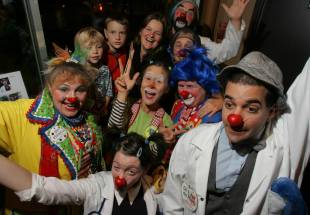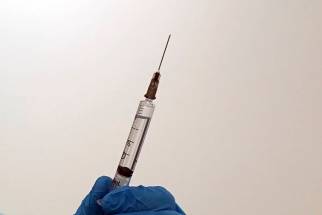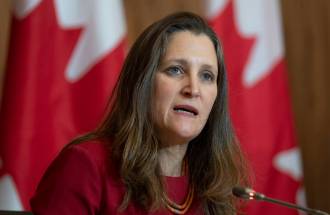No one laughing over clown therapy’s uncertain future
Read this article for free:
or
Already have an account? Log in here »
To continue reading, please subscribe:
Monthly Digital Subscription
$0 for the first 4 weeks*
- Enjoy unlimited reading on winnipegfreepress.com
- Read the E-Edition, our digital replica newspaper
- Access News Break, our award-winning app
- Play interactive puzzles
*No charge for 4 weeks then price increases to the regular rate of $19.00 plus GST every four weeks. Offer available to new and qualified returning subscribers only. Cancel any time.
Monthly Digital Subscription
$4.75/week*
- Enjoy unlimited reading on winnipegfreepress.com
- Read the E-Edition, our digital replica newspaper
- Access News Break, our award-winning app
- Play interactive puzzles
*Billed as $19 plus GST every four weeks. Cancel any time.
To continue reading, please subscribe:
Add Free Press access to your Brandon Sun subscription for only an additional
$1 for the first 4 weeks*
*Your next subscription payment will increase by $1.00 and you will be charged $16.99 plus GST for four weeks. After four weeks, your payment will increase to $23.99 plus GST every four weeks.
Read unlimited articles for free today:
or
Already have an account? Log in here »
Hey there, time traveller!
This article was published 14/03/2022 (1371 days ago), so information in it may no longer be current.
A pioneering therapeutic clown program that brings joy to Manitoba’s sickest children faces uncertainty as it is being reassessed by bureaucrats amid ardent calls for it to continue.
The Children’s Hospital program is believed to be the first of its kind in the world, delivering laughter and smiles to young patients with serious injuries or chronic conditions since 1986.
Supporters say a clown gives kids, parents and staff moments of levity in harrowing or stressful times, and distracts patients during painful or anxiety-inducing hospital procedures in scary or intimidating surroundings.
A hospital source, who claims the program is no longer being funded, is hopeful it will be “revived.”
“There have been a number of cutbacks over the years,” the source said. “It’s a great program, and I think we’ll see it happen again.”
Shared Health, which manages Health Sciences Centre and Children’s Hospital and their spending, insists the program isn’t being scrapped.
It is being “assessed” as part of a programming review that is looking at what other Canadian hospitals provide and how they use “updated” technology, said a spokesman, who declined to comment on the resident clown’s employment status.
“The therapeutic clown program is not coming to a close,” the spokesman wrote in an email.
The “planning work” began years ago, but was delayed by the COVID-19 pandemic, he said, adding Shared Health wants to extend programs to areas such as the emergency department.
The Shared Health spokesman said he was unable to get answers regarding the reason for the clown program’s reassessment, its annual cost and whether its funding has been pulled.
The clown therapy program is part of the hospital’s Child Life department, which includes an in-house TV station, music therapy, a toy playroom and libraries. March is Child Life Month.
“There have been a number of cutbacks over the years. It’s a great program, and I think we’ll see it happen again.” – Source
The clown program featured prominently in past Child Life literature and campaigns. It is not among the programs mentioned on a webpage for a current $500,000 fundraising campaign by the Children’s Hospital Foundation of Manitoba (CHFM).
“I believe it’s being reassessed,” CHFM president and CEO Stefano Grande wrote in an email in response to whether the program has been discontinued.
The hospital makes operational decisions based on staffing and programming to meet the “therapeutic, emotional and developmental needs” of patients and families, a spokeswoman for the foundation added.
According to HSC’s website, much of Child Life’s funding comes from CHFM donors. The website describes the clown program as “an integral part” of child health at HSC.
Shared Health’s review has sparked fears the program may not continue or may take on a different form in the future.
Karen Ridd, who came up with the idea and was its first clown, would be “heartbroken” if it ended.
“Winnipeg is seen as the parents of this global movement. It would be tragic for so many reasons to see the program discontinued.” – Karen Ridd
“Winnipeg is seen as the parents of this global movement,” she said. “It would be tragic for so many reasons to see the program discontinued.”
The program began when Ridd, a freelance entertainer who portrayed a silent mime clown named Robo, approached then-Child Life director Ruth Kettner.
When Kettner took her to a ward to visit patients, Ridd — wearing her clown costume — heard the cries of a young boy who was undergoing treatment after being mauled by a dog.
His eyes were fixed on her as she entered his room and began playing with one of his toy cars.
“Within minutes, he was playing and laughing with me,” said Ridd.
Convinced the program would be a good fit, Kettner found funding for the role of a therapeutic clown. Hospitals in several countries have copied it since then.
“This program, which people may feel is an add-on, is really essential. It makes a big difference because it helps kids to feel at home.” – Liberal MLA Dr. Jon Gerrard
Liberal MLA Dr. Jon Gerrard, former director of pediatric oncology and hematology at Children’s Hospital, wants the program to continue.
Ending it would be a “big mistake” because it helps children heal and recover, and a sign decision makers are “poorly informed” and don’t understand kids, said Gerrard, the MLA for River Heights.
“This program, which people may feel is an add-on, is really essential. It makes a big difference because it helps kids to feel at home.”
NDP Leader Wab Kinew agreed.
“We’re talking about brightening up the day of a young person going through tough times,” said the Leader of the Opposition and Fort Rouge MLA. “I would shudder to think the austerity agenda of government has gone so far that we can’t afford to help kids that are suffering.”

After starting the program, Ridd stayed on until 1989, and was followed by clowns Dianne Baker and David Langdon, who worked at the hospital until his retirement in 2019.
He was followed by Alexandra Bolton, who has a master’s degree in drama therapy.
Known as Dr. Bloomsie, she was “thoroughly vetted through performance evaluations by patients,” according to a Shared Health profile of Child Life in March 2021.
CHFM announced Bolton’s hiring in a series of social media posts that month, sharing a photo of her in costume.
“A new clown at HSC Winnipeg Children’s Hospital is bringing laughter, joy, and silliness to sick and injured kids!” posts on Facebook and Twitter stated. “This ‘doctor’ loves to dance, make jokes, and most of all give kids a reason to smile!”
“You’re one in a million Dr. Bloomsie, thank you,” the Winnipeg Regional Health Authority tweeted in response.
CHFM shared the same photo Jan. 15, as it promoted the program.
“The goal of the clown is to give children tools so they’re able to direct play, which is very meaningful in a setting like a hospital where they often don’t have much control,” a Facebook post read.
— With files from Malak Abas
chris.kitching@freepress.mb.ca
Twitter: @chriskitching
As a general assignment reporter, Chris covers a little bit of everything for the Free Press.
Our newsroom depends on a growing audience of readers to power our journalism. If you are not a paid reader, please consider becoming a subscriber.
Our newsroom depends on its audience of readers to power our journalism. Thank you for your support.









